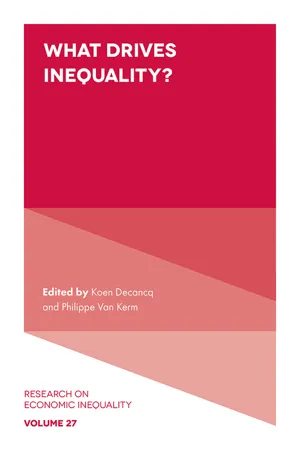This chapter studies trends in income distributions and inequality in the European Union using data from the European Union Statistics on Income and Living Conditions. The author models the income distribution for each country under a Dagum distribution assumption and using maximum likelihood techniques. The author uses parameter estimates to form distributions for regions defined as finite mixtures of the country distributions. Specifically, the author studies the groups of ‘new’ and ‘old’ countries depending on the year they joined the European Union. The author provides formulae and estimates for the regional Gini coefficients and Lorenz curves and their decomposition for all the survey years from 2007 through 2011. The estimates of this study show that the ‘new’ European Union countries have become richer and less unequal over the observed years, while the ‘old’ ones have undergone a slight increase in inequality which is however not significant at conventional levels.
1. INTRODUCTION
The European Union experienced several enlargements since the establishment of its predecessor, the European Economic Community, in 1957, from only six founding states – Belgium, France, Italy, Luxembourg, the Netherlands and (West) Germany – to 28 Member States today. One of the major enlargements happened in 2004 when countries from Central and Eastern Europe joined the European Union. The change in composition modified the income distribution and inequalities within the European Union. Even though it is currently the world’s largest economy, generating a nominal gross domestic product of approximately 14.303 trillion Euros according to International Monetary Fund (2014), if we look into its Member States individually, we see large differences in the income distribution between and within them.
This chapter adds to the literature on the distribution of income and inequality in the European Union, both for individual countries and regionally. The income distribution in European Union countries has been much researched either as part of the world distribution of income with inequality analyses based on grouped income data (for instance, Chotikapanich, Griffiths, & Prasada Rao, 2007; Chotikapanich, Griffiths, Prasada Rao, & Valencia, 2012; Milanovíc, 2002, 2005, 2012; Sala-i-Martín, 2006), or separately in inequality analyses at the country level (e.g. Filauro, 2017; Tóth & Medgyesi, 2011). Jenkins, Brandolini, Micklewright, & Nolan (2013) have studied the evolution of income distribution during the Great Recession in 21 rich OECD countries, Brzezinski (2018) has analysed the income inequality in Central and Eastern Europe, while Anderson, Pittau, Zelli, & Thomas (2018) have focussed on income classification in the Euro zone as an entity.
Like many recent studies, we use representative microdata from the European Union Statistics on Income and Living Conditions (EU-SILC) cross-sectional survey to study both inequality in individual countries, and in broader country groupings as ‘new’ and ‘old’ Member States. The ‘new’ countries are those which entered the European Union after 2004 and the ‘old’ are those which entered before 2004. We selected 2004 as the splitting year since this marked the largest expansion of the European Union.
This work makes three contributions to the literature. First, we provide new parametric model estimates for the income distribution of the European Union as a whole, for multicountry regional groupings, and for individual countries for each year from 2007 to 2011. We obtain the regional models as finite mixtures of the individual countries’ distributions. To derive the models, we fit the Dagum distribution via maximum likelihood techniques to the income data available for each of the European Union countries. Second, we provide formulae for the Gini coefficient and the Lorenz curve implied by Dagum distribution mixture models. We introduce an efficient way for computing the total Gini coefficient numerically and decompose the regional Gini coefficients into within- and between-country contributions. Third, our results show that the region formed by the ‘new’ Member States is more unequal and less wealthy than the region formed by the ‘old’ ones and we observe that inequality in the ‘new’ countries contributes substantially to overall inequality for the European Union as a whole. However, looking at the evolution of income distribution over time, we find that the ‘new’ Member States have become, on average, wealthier and more equal over time, while the ‘old’ Member States have undergone a slight increase in inequality. We provide R code for replicating estimations in an Online Supplementary Material (R Core Team, 2014).
Using parametric models for studying income distributions has several advantages. We can represent the income distribution of a country with a small number of estimated parameters (Chotikapanich et al., 2007, 2012; Hajargasht, Griffiths, Brice, Rao, & Chotikapanich, 2012), from which the distribution in larger entities, in our case regions, can be obtained in a straightforward way. We exploit this in Section 4 below. The model parameters often also possess an economic interpretation, which allows to gain insights about the causes of the evolution of income distribution over time or interpret the differences between income distributions across countries (Brzezinski, 2013). Explicit formulae are available for many poverty and inequality measures as functions of the parameters of the theoretical income distribution. Benefits of parametric models in terms of estimation stability are also put forward in Graf & Nedyalkova (2014).
Specifically, the Dagum distribution has been used successfully for fitting data from various sources (Dagum, 1977; García Pérez & Prieto Alaiz, 2011; Kleiber & Kotz, 2003). Dagum (1977) aimed to find a distribution that would capture the heavy tails present in wealth distribut...
